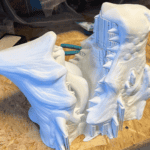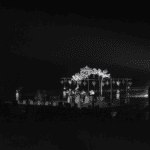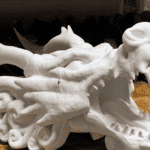A Look at Fluire Atelab's 3D Printed Statues for Carnevale di Venezia
The Carnevale di Venezia is renowned for its extravagant costumes and captivating performances, but this year, innovative design firm Fluire Atelab added another layer of magic with cutting-edge technology: 3D printing!
From Design to Fabrication: A Collaborative Effort
Fluire Atelab collaborated with The East Company – Associazione ICCTP to create four statues inspired by Chinese culture, aligning with the artistic direction of the show.
To create these beautiful statues, Fluire Atelab chose to use FormFutura EasyFil ePLA Snow white.

Recently, we completed a significant project for the Venice Carnival, held at the Arsenale, where we extensively used FormFutura Easyfil ePLA filaments. We have collaborated with The East Company – Associazione ICCTP, and we made 4 different statues in theme with Chinese culture and the artistic direction of the show.
Mariano Barbato - Fluire Atelab
Making the statues

Digital Design - Designing the statues
To design the statues, we asked artist Andrea Mastrangelo to use his expertise in Blender software to design the four detailed heads. Fluire Atelab then designed a way to securely attach the heads to pedestals.
Material Selection
We did extensive research on what 3D printing materials to use. We had to take into consideration that the location of the Arsenale raft, would be on the water under winter conditions!
That is why Fluire Atelab opted for FormFutura EasyFil ePLA Snow White filaments. Because the shows would be only played at night, the PLA's sun resistance wasn't crucial for this project.
Printing and Assembly
To print the statues, a total of nine kilograms of EasyFil ePLA filament was used to print the heads in a couple or larger sections. After printing, the team glued the parts together with cyanoacrylate adhesive, giving the statures their final shape. To finish the 4 unique statues and give them a smooth outer layer, we filled them with spray filler and lightly sanded them to prepare for paint.
Painting and Display: To really bring these statues to life, they needed to have the best paint job we could deliver. That final touch came from the client's painter, who brought the statues to life with incredible and vibrant colors. The finished creations were then proudly displayed at the show.
Challenges and Solutions:
One of the main challenges we faced was the sheer size of the statues. Fortunately, the 3D printer we designed and built, with its 500x500mm build plate, enabled us to create larger pieces more effectively. Moreover, our dedicated team managed to design the 3D models, print, glue, and paint all the models in just one month’s time!
Benefits of 3D Printing
The 3D printing process brought significant benefits to the table for this kind of task. It allowed us to produce models with high fidelity and intricate detail, closely matching the visions of our client. It was the best solution considering the quality-cost ratio that 3D printing can offer, ensuring premium results without compromising on the budget.

Software and Hardware
On the hardware front, we utilized two printers that were personally designed and built by myself and my colleague, a researcher at the University of Padova, Department of Mechanical Engineering. The primary printer used for the project was the Z3R500, boasting a 500x500x400mm build volume. For parts that fit within a smaller dimension, we employed our second in-house created printer, the Z3R220, with a 220x220x350mm build plate. These printers proved to be both reliable and precise for this assignment.
Before discussing the slicing software, it’s essential to highlight an innovative contribution from our team: a patented algorithm that revolutionizes how we calibrate new filament types. This algorithm allows us, by means of the classic single shelled calibration cube print, to adjust the material flow rate (or extrusion multiplier) in order to reduce air gaps in solid fill regions and, therefore, maximize strength.
This advancement has significantly reduced the time needed for filament calibration and material wastage. We maintain a continuously updated Excel file that aids in this process, integrating its outputs directly into Ideamaker. For optimal printing results and ensuring that the pieces exhibit the best mechanical properties, and dimensional accuracy.
For the slicing software, we opted for Ideamaker, setting up a profile with adaptive infill to reduce the use of PLA. This was a strategic choice as the statues were required to fulfill an aesthetic role rather than a structural function within the context of the floating platform used for the display.

Ideamaker
(click the image to enlage)
The Future of 3D Printing
As a multidisciplinary team comprised of an architect and a mechanical engineer, we are increasingly recognizing how additive manufacturing is expanding into the realm of temporary exhibitions, influencing both interior and exterior design. With the years, we see a clear trend toward the need for larger-scale print capabilities to keep pace with the times. Therefore, we are committed to developing larger printers that will enable us to integrate seamlessly into the dynamic context of events, exhibitions, and both temporary and permanent installations.
For this project, we placed our trust in FormFutura as the supplier of 3D printer filaments, confident in the quality of your products. We selected The Easyfil line specifically for its aesthetic qualities, which also aligns with our thoughtful and efficient use of materials.
We have been 3D printing since 2017 and annually sort and save various types of waste from our prints. Not only that, but we are eager to breathe new life into the waste material we have been storing, exploring innovative recycling solutions.
In this case, the EasyFil ePLA line, seemed like an optimal choice. It proved excellent not only in aesthetic quality but also in the durability of the printed pieces, underscoring our commitment to sustainability without compromising on quality.









